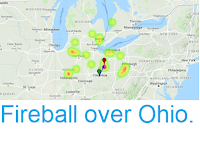The Southern Taurid Meteor Shower will peak on Monday 5 November 2018, the first of two overlapping meteor showers associated with Comet
2P/Encke that peak in early November, the second being the Northern
Taurids which will peak on Sunday 11 November. The showers take their
name from the constellation of Taurus, where their radiant point (the
point from which they appear to radiate) can be found. Viewing
of the Southern Taurids is should good this year, falling slightly before the New Moon on 7 November, though as the shower
only produces about 5 meteors per hour at peak, this is never the calender's most spectacular meteor shower.
The radiant point of the Taurid Meteors. In the Sky.
The Taurid Showers are caused by the Earth passing through the trail of
Comet 2P/Encke, this is particularly spread out, so that the Earth takes
several weeks to pass through it. This is thought to be because Encke
is a remnant of a much larger Comet, which has broken up over the past
20 000 to 30 000 years, giving a long, spread-out debris stream that has
been shepherded into two main substreams by tidal interactions with the
Earth.
2P/Encke. Gerald Rhemann/Comet Watch.
Comet 2P/Encke was first observed by French astronomer Pierre Méchain in 1786, but gets its name from the German astronomer Johann Franz Encke, who calculated its orbit in 1818. The designation 2/ implies that it was the second Periodic Comet (comet with an orbital period of less than 200 years) ever discovered.
Comet 2P/Encke completes one orbit every 1204 days (3.3 years) on an eccentric orbit tilted at 11.8° to the plane of the Solar System, that takes it from 0.34 AU from the Sun (34% of the average distance at which the Earth orbits the Sun, and inside the orbit of the planet Mercury) to 4.09 AU from the Sun (4.09 times as far from the Sun as the Earth,considerably more than twice the distance at which the planet Mars orbits the Sun).
See also...
Follow Sciency Thoughts on Facebook.









